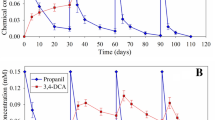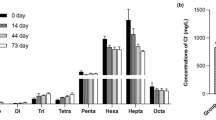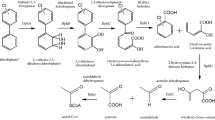Abstract
Many industrial locations have identified the need for treatment of polychlorinated biphenyl (PCB) wastes and remediation of PCB-contaminated sites. Biodegradation of PCBs is a potentially effective technology for treatment of PCB-contaminated soils and sludges; however, a practicable remediation technology has not yet been demonstrated. In laboratory experiments, soil slurry microcosms inoculated with microorganisms extracted from PCB-contaminated Hudson River sediments have been used for anaerobic dechlorination of weathered Aroclor 1248 in contaminated soil with a low organic carbon content. Anaerobic incubation was then followed by exposure to air, addition of biphenyl, and inoculation withPseudomonas sp. LB400, an aerobic PCB degrader. The sequential anaerobic-aerobic treatment constituted an improvement compared to anaerobic or aerobic treatment alone by reducing the total amount of PCBs remaining and decreasing the tendency for end products to accumulate in humans. A 70% reduction of PCBs was observed during sequential treatment with products containing fewer chlorines and having a shorter half-life in humans than the original PCBs. The aerobic treatment alone was also quite effective as a stand-alone treatment reducing the PCBs by 67%. The results represent a case in which anaerobic river sediment organisms have been successfully transferred to a matrix free of river or lake sediments.
Similar content being viewed by others
References
Erickson, M. D. (1986), inAnalytical Chemistry of PCBs. Butterworth Publishers, Stoneham, MA, pp. 1–34.
Safe, S. H. (1994),Crit. Rev. Toxicol. 24, 86–149.
Brown, J. F., Jr. (1994),Environ. Sci. Technol. 28, 2295–2305.
Abramowicz, D. A. (1990),Crit. Rev. Biotechnol. 3, 241–251.
Chen, M., Hong, C. S., Bush, B., and Rhee, G.-Y. (1988),Ecotoxicol. Environ. Safety 16, 95–105.
Rhee, G.-Y., Bush, B., Brown, M. P., Kane, M., and Shane, L. (1989),Water Res. 23, 957–964.
Barton, J. W., Klasson, K. T., and Reeves, M. E. (1995), Investigation of Anaerobic Microbial PCB Dechlorination for Field Demonstration, presented at the 17th Symposium on Biotechnology for Fuels and Chemicals, Vail, CO, May 7–11.
Boyle, A. W., White, N., and May, H. D. (1992), Anaerobic dechlorination of 2,3,6-trichlorobiphenyl: an analysis of the requirement for humic acids and a determination of suitable sources of carbon and energy, presented at the ASM Conference on Anaerobic Dehalogenation and Its Environmental Implications, Athens, GA, August 30–September 4.
Shelton, D. R. and Tiedje, J. M. (1984),Appl. Environ. Microbiol. 48, 840–848.
Cole, J. R., Cascarelli, A. L., and Mohn, W. W. (1994),Appl. Environ. Microbiol. 60, 3536–3542.
Mohn, W. W. and Tiedje, J. M. (1992),Microbiol. Rev. 5, 482–507.
Niels, L. and Vogel, T. M. (1990),Appl. Environ. Microbiol. 56, 2612–2617.
Linkfield, T. G. and Tiedje, J. M. (1990),J. Ind. Microbiol. 5, 9–16.
Hendriksen, H. V., Larsen, S., and Ahring, B. K. (1992),Appl. Environ. Microbiol. 58, 365–370.
Klasson, K. T. and Evans, B. S. PCB dechlorination in anaerobic soil slurry reactors, in papers:IGT’s 7th International Symposiumfor Oil, Gas, and Environmental Biotechnology, Institute of Gas Technology, Chicago, IL, in press.
Boyle, A. W., Green, L., May, H. D., and White, N. (1992), in11th Progress Report on the Research and Development Program for the Destruction of PCBs, General Electric Company Corporate R&D Center, Schenectady, NY, pp. 227–250.
Bedard, D. L., Van Dort, H. M., May, R. J., Principe, J. M., Smullen, L. A., and DeWeerd, K. A. (1993), Bromobiphenyls stimulate anaerobic dechlorination of Aroclor 1260 contaminant in sediment slurries, presented at the 2nd International Symposium for In Situ and On-Site Bioreclamation, San Diego, CA, April 5–8.
Shannon, M. J. R., Rothmel, R., Chunn, C. D., and Unterman, R. (1994), inBioremediation of Chlorinated and Polycyclic Aromatic Hydrocarbons, Hinchee, R. E., Leeson, A., Semprini, L., and Ong, S. K., eds., Lewis Publishers, Boca Raton, FL, pp. 354–358.
Tiedje, J. M., Quensen, J. F., III, Chee-Sanford, J., Schimel, J. P., and Boyd, S. A. (1993),Biodegradation 4, 231–240.
Anid, P. J., Niels, L., and Vogel, T. M. (1991), inOn-Site Bioreclamation: Processes for Xenobiotic and Hydrocarbon Treatment, Hinchee, R. E. and Olfenbuttel, R. F., eds., Butterworth-Heinemann, Boston, MA, pp. 428–436.
Buckman, H. O. and Brady, N. C. (1969),The Nature and Properties of Soil, 7th ed. The Macmillan Company, New York, NY, p. 151.
Bedard, D. L., Wagner, R. E., Brennan, M. J., Haberl, M. L., and Brown, J. F., Jr. (1987),Appl. Environ. Microbiol. 53, 1094–1102.
Brown, J. F., Jr., Wagner, R. E., Bedard, D. L., Brennan, M. J., Camahan, J. C., May, J. J., and Tofflemire, T. J. (1984),Northeast. Environ. Sci. 3, 167–179.
Brown, J. F., Jr., Wagner, R. E., Feng, H., Bedard, D. L., Brennan, M. J., Camahan, J. C., and May, R. J. (1987),Environ. Toxicol. Chem. 6, 579–593.
Brown, J. F., Jr., Bedard, D. L., Brennan, M. J., Camahan, J. C., Feng, H., and Wagner, R. E. (1987),Science 236, 709–712.
Shultz, D. E., Petrick, G., and Duinker, J. C. (1989),Environ. Sci. Technol. 23, 852–859.
Quensen, J. F., III, Boyd, S. A., and Tiedje, J. M. (1990),Appl. Environ. Microbiol. 56, 2360–2369.
Bedard, D. L., Unterman, R., Bopp, L. H., Brennan, M. J., Haberl, M. L., and Johnson, C. (1986),Appl. Environ. Microbiol. 51, 761–768.
Taylor, J. K. (1990), inStatistical Techniques for Data Analysis, Lewis Publishers, Chelsea, MI, p. 46.
Author information
Authors and Affiliations
Rights and permissions
About this article
Cite this article
Evans, B.S., Dudley, C.A. & Klasson, K.T. Sequential anaerobic-aerobic biodegradation of PCBs in soil slurry microcosms. Appl Biochem Biotechnol 57, 885–894 (1996). https://doi.org/10.1007/BF02941769
Issue Date:
DOI: https://doi.org/10.1007/BF02941769




